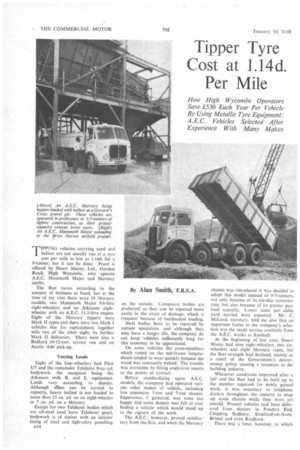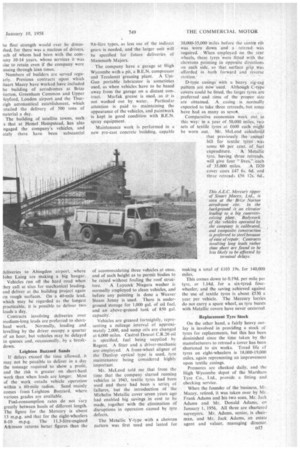Tipper Tyre Cost at 1 . 14 d.
Page 54

Page 55

If you've noticed an error in this article please click here to report it so we can fix it.
Per Mile
How High Wycombe Operators Save £530 Each Year Per Vehicle By Using Metallic Tyre Equipment: A.E.C. Vehicles Selected After Experience With Many Makes By Alan Smith, F.R.S.A. TIPPING vehicles carrying sand and I ballast arc not usually run at a tyre cost per mile as low as 1.14d. for a 9-tonner, but it can be done. Proof is offered by Stuart Macey, Ltd., Gordon Road, High Wycombe, who operate A.E.C. Mammoth Major and Mercury outfits.
The fleet varies according to the amount of business in hand, but at the time of my visit there were IO Mercury models, two Mammoth Major 9.6-litre eight-wheelers and an Atkinson eightwheeler with an A.E.C. 11.3-litre engine. Eight of the Mercury tippers were Mark H types and there were two Mark I vehicles due for replacement, together with two of the othdr eight, by further Mark II deliveries. There were also a Bedford 10-I2-cwt. service van and an Austin A40 pick-up.
Varying Loads Eight of the four-wheelers had Pilot U7 and the remainder Tclehoist 8-cu.-yd. bodywork, the exception being the Atkinson with B. and E. equipment. Loads vary according to density. Although allies can be carried to capacity, heavy ballast is not loaded to more than 12 cu. yd. on an eight-wheeler or 7 cu. yd. on a Mercury.
Except for two Telehoist bodies which are all-steel (and have Telelever gear), bodywork is of timber with an interior lining of steel and light-alloy panelling DI4
on the outside. Composite bodies are preferred; as they can be repaired more easily in the event of damage, which is frequent because of mechanical loading.
Steel bodies have to be repaired by outside specialists. and although they may have a longer life, the company do not keep vehicles sufficiently long for this economy to be appreciated.
On some vehicles the cross-members which rested on the sub-frame longitudinals tended to wear quickly because the wood was constantly wetted. The trouble was overcome by fitting angle-iron inserts at the points of contact.
Before standardizing upon A.E.C. models, the company had operated various other makes of vehicle, including less expensive 5-ton and 7-ton chassis. Experience, I gathered, was none too happy and some despair was felt at ever finding a vehicle which would stand up to the rigours of the work.
The A.E.C., however, proved satisfactory from the first, and when the Mercury chassis was introduced it was decided to adopt this model instead of 5-7-tonners, not only because of its sturdier construction, but also because of its greater payload capacity. Lower costs per cubic yard carried were expected. Mr. C. McLeod, secretary, told me also that an important factor in the company's selection was the ready service available from the A.E.C. works at Southall.
At the beginning of last year, Stuart Macey had nine eight-wheelers, two sixwheelers and eight Mercury types, but the fleet strength had declined, mainly as a result of the Government's dearermoney policy causing a recession in the building industry.
Whenever conditions improved after a lull and the fleet had to be built up to the number required for newly gained work, it was necessary to telephone dealers throughout the country to snap up stock chassis while they were yet unsold. Present vehicles had been delivered from dealers in Ponders End. Chipping Sodbury, Stratford-on-Avon. Bristol and even Bradford.
There was a limit, however, to which
he fleet strength would ever be dimindied, for there was a nucleus of drivers, ach of whom had been with the comany 10-14 years, whose services it was rise to retain even if the company were assing through lean times.
Numbers of builders are served reguarly. Previous contracts upon which ;Wart Macey have worked have included he building of aerodromes at Brize storton, Greenham Common and Upper ieyford, London airport and the Thureigh aeronautical establishment, which Mailed the delivery of 500 tons of naterial a day.
The building of satellite towns, such • s that at Hemel Hempstead, has also ngaged the company's vehicles, and ately there have been substantial Jeliveries to Abingdon airport, where John Laing are making a big hangar.
Vehicles run off the hard road when :hey call at sites for mechanical loading, Lind deliver at the building project again on rough surfaces. On a 40-mile lead,. which may be regarded as the longest practicable, it is possible to deliver two loads a day.
Contracts involving deliveries over medium-long leads are preferred to shorthaul work. Normally, loading and levelling by the driver occupy a quarter of an hour, but vehicles may be delayed in queues and, occasionally, by a breakdown.
Leighton Buzzard Sands
Tf delays exceed the time allowed, it may not be possible to deliver in a day the tonnage required to show a profit, and the risk is greater on short-haul work than when leads are longer. Most of the work entails vehicle operation. within a 60-mile radius. Sand mainly comes from Leighton Buzzard, where various grades are available.
Fuel-consumption rates do not vary greatly between hauls of different length. The figure for the Mercury is about 13 m.p.g. and that for the eight-wheelers 8-10 m.p.g. The 11.3-litre-engined Atkinson returns better figures than the 9.6-litre types, as less use of the indirect gears is needed, and the larger unit will be specified for future deliveries of Mammoth Majors.
The company have a garage at High Wycombe with a pit, a B.E.N. compressor and Tecalemit greasing plant. A UniGun portable lubricator is sometinies used, as when vehicles have to be based away from the garage on a distant con-.
tract. Marfak grease is used, as it is not washed out by water. Particular attention is paid to maintaining the appearance of the vehicles, and paintwork is kept in good condition with B.E.N. spray equipment.
Maintenance work is performed in a new pre-cast concrete building, capable of accommodating three vehicles at once, and of such height as to permit bodies to be raised without fouling the roof struc ture. A Laycnck Niagara washer is normally employed to clean vehicles, and before any painting is done a Weaver Steam Jenny is used. There is underground storage for 1,000 gal. of oil fuel, and an above-ground tank of 850 gal. capacity.
Vehicles are greased fortnightly, representing a mileage interval of approximately 2,000, and sump oils are changed at 6,000 miles. Castrol Deusol C.R.20 oil is specified, fuel being supplied by Regent. A fitter and a driver-mechanic are. employed. A front-wheel aligner of the Dunlop optical type is used. tyre maintenance being considered highly important.
Mr. McLeod told me that from the time that the company started running vehicles in 1943, textile tyres had been used and there had been a seriq of failures, but the introduction of the Michelin Metallic cover seven years ago had enabled big savings in cost to be made, together with the elimination of disruptions in operation caused by tyre defects.
The Metallic Y-type with a chevron pattern was first used and lasted for 30,000-35,000 miles before the centre rib was worn down and a retread was required. When employed on the rear wheels, these tyres were fitted with the chevrons pointing in opposite directions on each side, so that surface grip was . afforded in both forward and reverse motion.
D-type casings with a heavy zig-zag pattern are now used. Although C-type covers could he fitted, the larger tyres are preferred and rims of the proper size are obtained. A casing is normally expected to take three retreads, but some have had as many as seveR.
Comparative economics work out in this way: in a year of 50,000 miles, two sets of textile tyres at £600 each might be worn out. Mr. McLeod calculated that previously the annual bill for textile tyres was some 60 per cent. of :fuel expenditure. A Metallic lyre, having three retreads, will give four "lives," each of 35,000 miles. A D20 cover costs £47 6s. 6d. and three retreads £56 12s. 6d.,
making a total of £103 19s. for 140,000 miles.
This comes down to 0.19d. per mile per tyre, or 1.14d. for a six-tyred fourwheeler, and the saving achieved against the use of textile tyres is about £530 a year per vehicle. The Mercury lorries do not carry a spare wheel, as tyre bursts with Metallic covers have never occurred.
Replacement Tyre Stock On the other hand, a fairly heavy outlay is involved in providing a stock of tyres for replacements, but this has been diminished since the tithe taken by the manufacturers to retread a bover has been shortened to six weeks. Tread life of tyres on eight-wheelers is 18,000-19,000 miles, again representing an improvement upon textile casings.
Pressures are checked daily, and the High Wycombe depot of the Marsharn Tyre Co.. Ltd.. provide a fitting and checking service.
When the founder of the business, Mr. Macey, retired, it was taken over by Mr. Frank Adams and his two sons, Mr. Jack Adams and Mr. Donald Adams, on January 1, 1956. All three are chartered surveyors. Mr. Adams, senior, is chairman, and Mr. Jack Adams, an estate agent and valuer, managing director.
















































































































